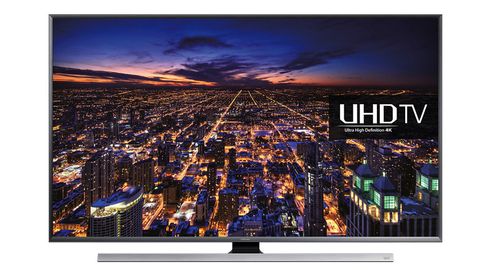TechRadar Verdict
Treated in isolation, the UE48JU7500 is an excellent TV, however, its 48-inch screen doesn't quite sell its curved screen convincingly enough to persuade me that it's really worth £250 over the flat-screen UE48JU7000.
Pros
- +
Excellent picture quality
- +
Good smart TV system
- +
Impressive 3D
- +
Easy to use
Cons
- -
Expensive versus flat models
- -
Reflective screen
- -
Clouding during off-axis viewing
- -
Screen barely big enough
Why you can trust TechRadar
The UE48JU7500 is a 48-inch TV that sits just above the centre of Samsung's new UHD TV range. In specification terms it's vey similar to the previously tested Samsung UE48JU7000, with one major exception.
Its screen is curved rather than flat.
The JU7500 wears this curve very attractively, thanks to the way the concave screen is married to a skinny and boldly chamfered bezel and a striking forward-thrusting single-bar stand. That said, its dark grey finish doesn't look anything like as opulent as the shinier metallic finish of Samsung's premium JS9500 and JS9000 TVs.

Despite being relatively affordable when compared with its high-end Samsung TV siblings, the UE48JU7500's curved screen and 3840 x 2160 native resolution aren't by any means its only attractions.
Also catching the eye is Samsung's new Tizen smart TV platform.
Samsung has long led the way in terms of the amount of online content its smart platform supports, especially when it comes to video streaming services, and the shift to Tizen hasn't changed this – despite the facts that a) other brands are now catching up fast and b) that at the time of writing a few key apps still aren't finalised for the Tizen platform.
It's a relief to find, too, that the Netflix and Amazon streaming apps both support 4K UHD.
Tizen talk
As for the interface Tizen introduces, it's a big leap forward from the rather dictatorial and convoluted system Samsung has used on its Smart TVs for the past few years.
Particularly welcome is the shift from full-screen menus to neat, attractive overlaid menus that make much more effective use of the available screen real estate, and try much harder to give you more direct access to the content you most want to watch.
Emphasis is given to recently used apps and TV channels, and you can manually pin favourite content sources to the TV's Home menu.
At the time of writing, Samsung's Tizen TVs aren't equipped with the clever learning system found on Samsung's previous smart TVs, which monitored what you liked to watch and made content recommendations accordingly. This is a pity, since at the moment the Tizen approach almost feels slightly too simplistic at times – at least when you first start using it.
Happily there's good news ahead though, for Samsung informs me that it will be introducing a learning/recommendations element via firmware update later this year.
Another surprising but welcome feature of the UE48JU7500 is its direct LED lighting system.
This finds the lights illuminating its pictures placed behind the LCD panel rather than around its edges – an approach that usually leads to a better contrast performance than you tend to get with edge LED TVs.
The UE48JU7500 can even control the light output of different sectors of its LEDs individually, to help bright picture areas look brighter and dark picture areas look darker.
Colour booster
The UE48JU7500 doesn't carry the Nano Crystal hardware colour solution delivered by Samsung's SUHD models, but it does employ the brand's PurColour processing engine to deliver an expanded colour range.
The set also boasts a host of other processing elements, including: an improved system for tweaking images to help them better suit the curved screen; block and general noise reduction systems; multi-level motion processing; and a still sadly much-needed system for converting HD – and even standard definition – to the screen's native 4K UHD resolution.
Connections on the UE48JU7500 are shared between the main TV body and an external Mini One Connect box. It seems a bit strange that you have to connect your Freeview HD and Freesat HD connections directly into the TV while you stick your HDMI sources into an external box, but we guess the Mini One Connect does at least reduce the amount of cable spaghetti going into the back of the TV.
No One Connect Upgrade

It's important to stress that unlike the grown up One Connect box you get with Samsung's JS9500 and JS9000 TVs, the Mini version does not carry any processing inside, and so can't be upgraded in the future like the full-bore One Connect can.
One last thing to cover on the UE48JU7500T's spec list is its 3D playback.
This is of the active variety (the passive system belongs to arch rival LG), but isn't, alas, supported by the inclusion of any free 3D glasses with the TV.
If you've been bitten by the high dynamic range bug, then unfortunately the UE48JU7500 isn't for you as it just doesn't support it. Although given how many rival brands have started claiming they can add HDR to their TVs via firmware updates we can't help but wonder if the UE48JU7500s might get a similar upgrade at some point.
John has been writing about home entertainment technology for more than two decades - an especially impressive feat considering he still claims to only be 35 years old (yeah, right). In that time he’s reviewed hundreds if not thousands of TVs, projectors and speakers, and spent frankly far too long sitting by himself in a dark room.


